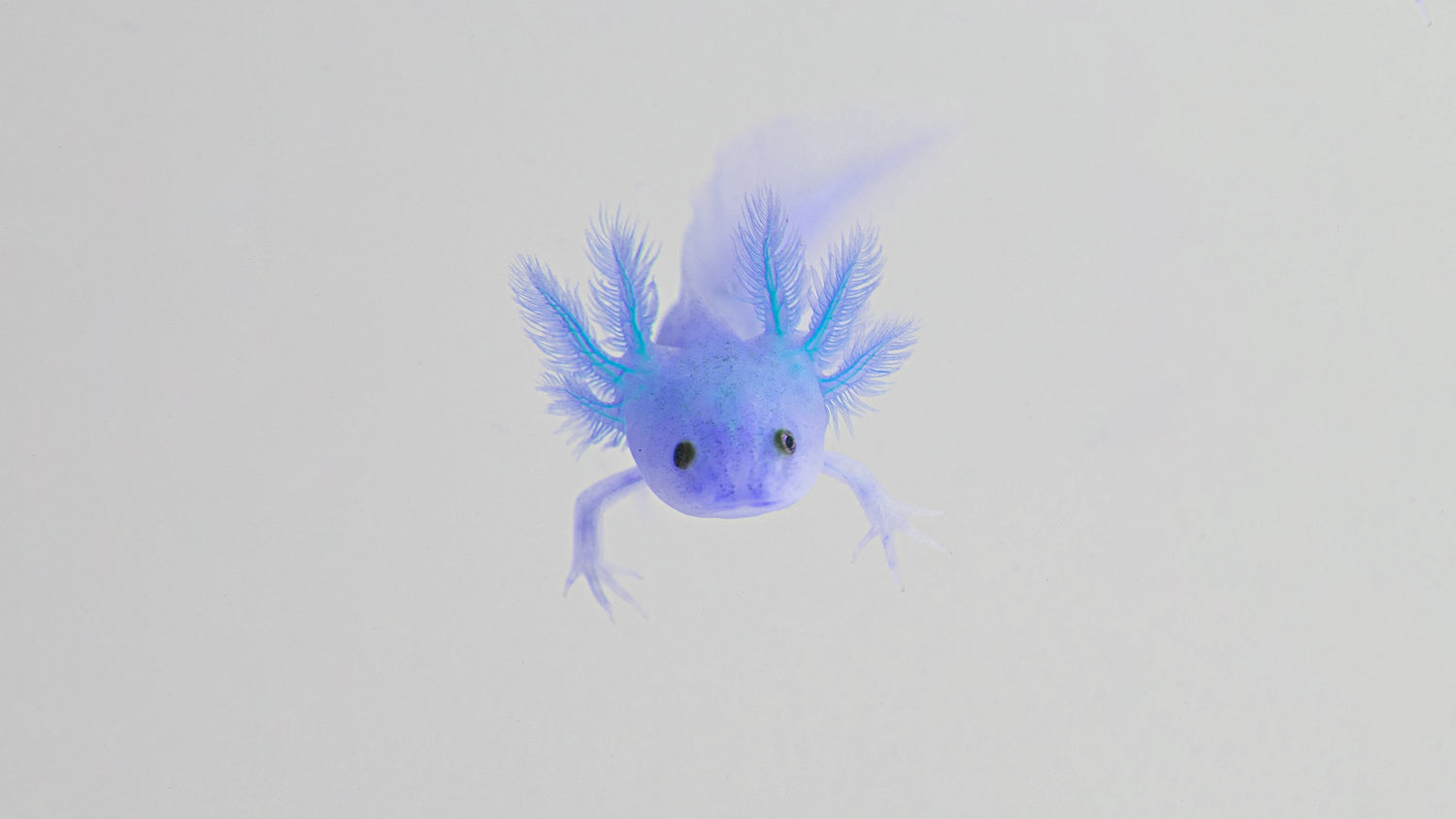Introduction
Many new axolotl enthusiasts frequently ask the question: Do blue axolotls exist? The answer to this is no, true blue axolotls do not exist. While there are many photos and videos on the internet of “blue” axolotls, these pictures and videos are either heavily edited or feature axolotls who have been dyed blue. It is not possible for an axolotl to have naturally occurring blue pigmentation.
What Gives an Axolotl Its Color?
An axolotl’s coloration is determined by its chromatophores. Chromatophores are skin cells that control the production of color in the axolotl’s skin. There are six major types of chromatophores that occur within aquatic animal species like salamanders, crustaceans and fish:
- Erythrophores - Red pigmented chromatophores.
- Iridophores - Chromatophores that are iridescent and reflect light.
- Leucophores - White pigmented chromatophores.
- Melanophores - Black or Brown chromatophores.
- Cyanophores - Blue chromatophores.
- Xanthophores - Yellow pigmented chromatophores.
Melanoid Axolotls
Axolotls do not possess erythrophores or cyanophores, so it is actually genetically impossible for an axolotl to be blue or even red. There is however another variation of axolotl that is the closest you can get to blue under certain lighting conditions. These axolotls are called melanoid axolotls which are actually black or very dark brown axolotls, but under certain lighting can oftentimes have a gray/blue appearance. It is important to note that these axolotls are actually black and it is merely a trick of the light that makes them appear blue. Below we have photographed one of our melanoid axolotls under different lighting to demonstrate this effect.
You can see in the top photo that this melanoid axolotl appears more black with some bluish tinting while in the photo below the axolotl appears more brown, but neither is actually blue. All morphs of axolotls can appear a slightly different color or hue depending on the type of lighting they are displayed under!
More About Melanoid Axolotls
If blue is your favorite color, and you want the closest thing to a real life blue axolotl, then a melanoid axolotl is what you are looking for! Melanoid axolotls are axolotls that do not produce iridophores (iridescent skin pigment) and have a decreased production of xanthophores (yellow pigmentation). This is what gives them their unique black appearance! Melanoid axolotls can be a smooth velvety black, being completely solid in color with slightly lighter bellies, or they can be a dark gray with darker spots all over them!
All melanoid axolotls are unique from other morphs because they completely lack a shiny ring around their eyes. Non-melanistic axolotls will have this shiny eye ring, which often appears gold or silver, and that is how you can tell the difference between a very dark wild type axolotl and a melanoid! You can also tell the difference between normal leucistic axolotls and leucistic melanoid axolotls using the same method! This shiny eye ring is actually a very important part of axolotl biology as it is composed of iridophores which reflect light and help the axolotl to see better. So, melanoid axolotls actually have poorer vision than other axolotls because there is nothing in their eyes to reflect the excess light!
What About Dyed Axolotls?
Some axolotl owners have been known to dye their pets in order to make them blue. This is extremely dangerous and Axolotl Planet considers this behavior to be abusive. We strongly discourage anyone from doing this to an axolotl or any other amphibious/reptilian animal. For the sake of education, we will go over some specifics as to why this is considered an abusive practice.
The reason why dyeing an axolotl is so bad is due to axolotls having very delicate skin. It is porous and covered in a slime coat that protects the axolotls from dangerous pathogens in the water around them. In order to dye an axolotl you would have to strip them of their slime coat which is an important component of keeping an axolotl healthy. This process alone can kill the axolotl.
Axolotl skin also passively absorbs oxygen and chemicals around it in the water which means that the dye can also be absorbed and poison the axolotl. Because of the lack of a functional slime coat and the absorption of harmful chemicals, this weakens the axolotl’s immune system, making it vulnerable to opportunistic bacterial and fungal infections which can be notoriously difficult to treat if intervention is not immediate.
Dye is also not permanent and will leach out of the axolotl’s skin into the water around it, which can create extremely dangerous water conditions that can potentially crash an established nitrogen cycle. All in all, dyeing an axolotl is a horrible practice that should never be done no matter how badly someone might want a uniquely-colored axolotl.
Conclusion
While the purported “blue” axolotl is in actuality a myth, there are still a wide variety of axolotl colors available that are just as capable of bringing you joy! Axolotls are wonderful and inquisitive creatures that make wonderful pets for anyone looking for something a little more exotic! For anyone looking to get an axolotl as a pet, we strongly recommend you read our Aquarium Cycling Guide and Bulletproof Care Guide to better prepare yourself for welcoming your new friend into your home!





Leave a comment
This site is protected by hCaptcha and the hCaptcha Privacy Policy and Terms of Service apply.